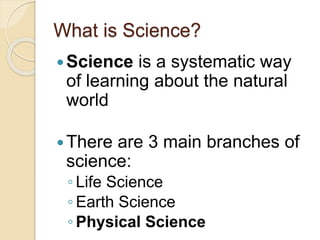
Intro to Physical Science (Grade 8: Class B ONLY)
- 1. What is Science? Science is a systematic way of learning about the natural world There are 3 main branches of science: ◦ Life Science ◦ Earth Science ◦ Physical Science
- 2. What is Physical Science? Physical Science is the study of matter and energy, and the changes they undergo ◦ Matter is anything that has mass and takes up space Mass = the amount of matter an object contains ◦ Energy is the ability to do work Physical science has two branches: ◦ Chemistry ◦ Physics
- 3. What is Physical Science? Chemistry = the study of the properties of matter and the changes they undergo Physics = the study of matter and energy and how they interact
- 4. How Scientists Think… They use skills of observation to learn more about the natural world.
- 5. Observation Observing = using one or more senses to gather information Two Types: ◦Quantitative observation ◦ Qualitative observation
- 6. Quantitative observations use numbers ◦ Example: measuring your height or weight Qualitative observations describe what you see; don’t involve numbers ◦ Example: Noticing that a ball is round or that it is raining outside
- 7. Look at this animal speed chart: What are some observations you can make?
- 8. The Scientific Method Definition: ◦ A logical, stepwise approach used by scientists to find answers to questions. Steps: ◦ 1. Observation: Observations are made by scientists about their surrounding environment. The observations allow scientists to ask questions. ◦ 2. State the Problem: The problem statement is in the form of a question. It is derived from the observations made by the scientist.
- 9. The Scientific Method ◦ 3. Form a Hypothesis: A hypothesis (an educated guess) is a possible explanation for the observation or problem. A hypothesis must be tested to determine its validity. ◦ 4. Conduct an Experiment: An experiment tests your hypothesis. ◦ 5. Analyze Data: Data (information gathered from the experiment) must be accurately recorded. Data can be displayed in a graph, chart, or table.
- 10. How to Display Data Graph Chart
- 11. How to Display Data Table
- 12. The Scientific Method ◦ 6. Form a Conclusion: Based upon the experimental results, conclusions can be made about the validity, or correctness, of your hypothesis. After many experiments that give the same results, a scientific theory may be formed.
- 13. The Scientific Method A scientific theory is a well-tested, verified hypothesis that fits existing data and explains how natural processes or events are thought to occur. It is a basis for predicting future events or discoveries. Theories may be modified as new information is gained. (Think back to your puzzle activity!)